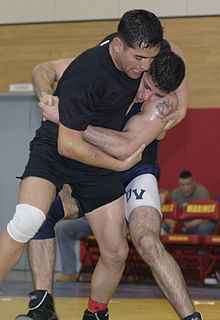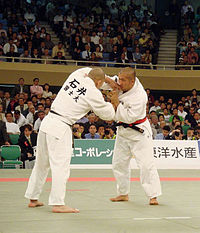Clinch fighting
This articleneeds additional citations forverification.(March 2024) |

Clinch fightingortrappingis the part ofstand-up fightingwhere the combatants aregrapplingin aclinch,typically usingclinch holds.Clinching the opponent can be used to eliminate the opponent's effective usage of somekicks,punches,andmelee weapons.The clinch can also be used as a medium to switch from stand-up fighting toground fightingby usingtakedowns,throwsorsweeps.
Clinch fighting is emphasized in bothstrikingmartial arts, such asMuay Thai,Lethwei,Bo xing,andSanda,as well asgrapplingmartial arts, such asWrestling,Judo,Sumo,SamboandBrazilian Jiu-Jitsu.
In combat sports
[edit]Clinch fighting is the primary focus of manycombat sportssuch aswrestlingand it is also a fundamental part ofamateur wrestling,sambo,Muay Thai,Lethweiandmixed martial arts.The nature of the clinch during fighting depends on the rules involved in the different sports. Muay Thai puts much emphasis onstrikesfrom the clinch, while judo focuses onthrows.The rule common to all these forms is the allowance for thegrapplingnecessary to form a clinch. Other combat sports likebo xingorTaekwondoonly allow clinching for a short time or do not allow it at all. If clinching is disallowed, the clinching fighter will be issued a warning, or therefereewill restart the fight from a distance.

Grappling techniques
[edit]The clinch is a powerful tool for grapplers to advance into adominant positioninground fighting,or is used for scoring points or winning a match such as agrand amplitude throwin amateur wrestling or anipponin judo. The type of techniques employed are heavily dependent on whether or not the participants are wearing clothing heavy enough to be grabbed and used to gain leverage or unbalance them to set up throws. In competitive environments examples of such clothing would be theDalian(Shuai JiaoJacket),Judogi,Brazilian Jiu Jitsu gior theKurtka.
In competition where such clothing is being worn (almost exclusively referred to as a gi) there is a strong emphasis on grip fighting where the fighters will attempt to gain a dominant hold on the opponent's gi to unbalance and throw them. Examples of such competition would be judo, sambo or some Brazilian Jiu Jitsu competitions although in BJJ there is frequently a division for both gi and no-gi competition.
In no-gi competition gettingdouble underhooksis generally considered advantageous, as the position can be used to perform throws ortakedowns.Being behind the opponent in such a position is known asgetting the back,and is generally considered even more advantageous, since it is harder for the opponent to defend from that position. A typical example of a technique that can be performed from this position is thesuplex.
Hand and arm positions
[edit]While clinching, the position of a fighter's arms is vitally important. The fighter always tries to keep his arms on the inside of his opponent's, allowing him to press his elbows together building a tighter grip. The fighter attempts to always hold his hands in a "cupping" position.[1]
Striking techniques
[edit]A multitude of striking techniques exist that can be used effectively from the clinch.Punching,elbows,andknee strikesin the clinch, also sometimes referred to as "dirty bo xing",are an important aspect of Muay Thai,Bajiquan,Wing Chun,Lethwei and mixed martial arts.Elbowsand short looping punches such ashooksanduppercutscan be used effectively from thesingle collar tieposition. Although disallowed in many combat sports, in Lethwei, the use ofheadbuttis encouraged and can also be effectively used from the clinch. The short distance in the clinch nullifieskickingto some extent, but some kicks are still effective. InWing Chun,simultaneous grabs/traps at the elbows, wrists or behind the neck often open up a strike. In Muay Thai, thedouble collar tieis used to control an opponent whilekneeingto the head or midsection, andstompsare used in some mixed martial arts competitions to kick the feet of the opponent.
Submission techniques
[edit]There are very fewsubmission holdsthat can be applied effectively from the clinch, without engaging inground fighting.The most well known submission hold is theguillotine choke,which can be attempted from asingleordouble collar tie.Height is advantageous in applying the guillotine choke from the clinch, since sufficient leverage is needed. Other possible, but more rare submissions from the clinch are thearm triangle,rear naked choke,andEzekiel choke.
See also
[edit]References
[edit]- Danaher, John.Fighting in the Clinch: A Key Skill in Real Fighting.realfighting.URL last accessed January 7, 2006.
- Gracie, Renzo; Danaher, John.Two Approaches to Fighting in the Clinch*.humankinetics.URL last accessed January 7, 2006.
- Pedreira, Roberto.The Subtle Science of the Muay Thai Clinch.URL last accessed December 16, 2006.
- ^Bradshaw, B (28 September 2023)."Clinch Fighting: A How to Guide for Muay Thai".Muaythai.Muay Thai.Retrieved23 March2024.
